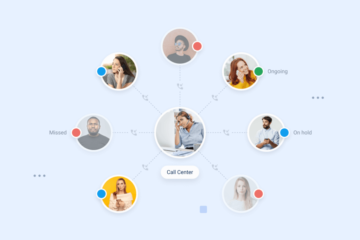Contents:
– Know what’s your first contact resolution rate 👍
– Regularly update your knowledge base 🧠
– Avoid leaving customers on hold ⌛
– Anticipate issues your customers may have before they call ⚠️
– Make full use of automation tools 🤖
– Invest in your operators 💰
– Measure the progress of your FCR rate 📈
Good customer service is all about a speedy resolution. If a customer can find a solution to their problem in a single interaction, they’ll view the experience in a positive light.
The goal is to offer a solution to a customer’s problems on their first contact with you, otherwise known as first contact resolution (FCR). FCR is so crucial you can measure a company’s success by it.
What’s important is your support agents’ skill in delivering the right answer. You can measure your first call resolution rate by looking at the number of cases solved by your support team during their first communication with clients out of the overall number of requests they receive.
Put simply, a strong FCR is a good indicator that your team is providing excellent service. The higher your FCR rate, the greater your customer experience and the higher your company will be ranked.
Customers who receive the solutions they need quickly will come away feeling as if they’ve had much better customer service. In addition, strong FCR reduces churn and turns customers into brand fans. As we all know, levels of satisfaction can make or break a business.
So, how exactly do you increase your first call resolution rate? Read on to discover eight best practices.
Before trying to improve your FCR rate, it’s important to establish how you measure up. Set up real-time feedback by asking customers if their issue has been resolved. Another way to do this is to track how many calls come in within a set period and use speech analytics to flag phrases such as “last time I called” or “I’m calling again”.
Ensure you’re using the correct contact touchpoints. This could include a VoIP provider that delivers voice calling over the internet. Voice over internet protocol (VoIP) is more flexible than landline as it allows users to connect via their smartphones, laptops, or desktop computers.

2. Regularly update your knowledge base
At the core of good customer support is a knowledge base with a smart FAQ. This should provide product know-how and answers to the most commonly asked questions. Ensure this is easy to navigate and offers simple yet comprehensive answers so customers can find what they’re looking for without contacting you.
Strictly speaking, this won’t technically help first call resolution because your customer shouldn’t need to contact you, but self-service support goes a long way to keeping customers happy and enabling the speedy resolution of issues. An excellent knowledge base or help center, with well-written articles and a well-thought-out structure, opens a valuable support line between you and your clients.
Content should be organized to ensure information is easily accessible. Use a clean and attractive design with a prominent search bar. This will help users find the answers they need in as few clicks as possible.
3. Avoid leaving customers on hold
People are impatient. The world has sped up and we don’t have the time nor patience to sit listening to background music, recorded messages, or menu choices. The more effort it requires for a customer to get through to a member of the support team, the more frustrated they’ll feel.
If your agents have the authority to make decisions, this will speed up the process.
You should be aiming for a smooth and responsive service. Using a video call app, for example, will allow you to screen share and use online video chat.
Make sure your support staff has access to a list of support services, such as accounts, and software knowledge, so they can consult these without ending or prolonging the call. They should be able to collaborate with other personnel in real-time to solve issues directly.
A support operator should isolate the issue that led to the customer getting in touch and ask them if this has been resolved before ending the call. They should also be taught how to stay on topic to resolve issues faster.
4. Anticipate issues your customers may have before they call
If customers aren’t given clear instructions or don’t feel as if they’ve received a proper answer to their query, they’re likely to call again. One way around this is to ask for customer feedback. That way you can anticipate the type of questions your clients will have.
Try to be proactive. This way, you won’t end up with customers needing to call back with another question. Think about the type of things your client will be thinking about after the call is over.
One of the golden rules of good customer service is to anticipate the problems customers may run into before they happen. Reading customer feedback will bring you valuable insight and help you to forecast any likely roadblocks.
Different problems call for different solutions. Customer queries aren’t always straightforward, which is why it’s important to use the best automation tools available. Equipping your team with market-leading tools isn’t only good business practice – it’s crucial to prevent churn.
According to the US CallMiner Churn Index 2020, nearly 74 percent of consumers switch providers after a poor customer experience. As well as customer service automation software, chatbots, and live chat options, having an interactive voice response system (IVR) makes a lot of sense.

But first of all, what is IVR and how can you use it within your customer support setup? Interactive voice response is a form of speech recognition technology for support lines and contact centers. It allows customers to access a support line or be directed to a relevant department.
You should also look at automating processes using robotic process automation (RPA). This allows software robots to observe, learn, mimic, and execute human digital actions in a way that improves on these.
6. Invest in your operators
Your support staff should be equipped with the most in-depth knowledge available. The better their understanding of your product and services, the more effectively they’ll deal with difficult and complex customer inquiries.
They should be trained in cross-channel communication strategies so they’re better able to respond to queries and sort problems out the first time around. Ensure your customer service team can easily access crucial information and is familiar with usual business practices such as zero party data.
Think about how your customer support team interacts with customers in terms of relationships too. Emotional intelligence is a vital part of understanding customer needs. Good customer experiences are typically a result of support agents displaying a high level of emotional intelligence, which allows staff to empathize with angry customers, build a rapport, and make them feel at ease.
If most customer calls involve an endless variation on the same two or three themes, it’s time to tackle these pain points head-on. Whether they’re tech problems, issues with understanding instructions, or worries about returns, your customers’ problems will become your agents’ problems. You need to provide solutions your customers (and agents) can easily access.

Invest in customer service technology that collects the type of customer intel your support staff will need. This will help you to develop a knowledge base and FAQs that work to answer common questions and that your staff can guide callers through using.
If necessary, actively point your customers to your support center and the information they’re seeking. They may not even realize these resources exist, so lead them to them and put the power of learning in their hands.
8. Measure the progress of your FCR rate
There are several ways of doing this. Firstly, ask customers if their issues have been resolved either on the phone or through post-contact surveys. It’s a good idea to leave customer feedback tickets open for at least a day.
Another idea is to ask agents to evaluate one another. Once operators know their FCR performance is being assessed, their rates will go up. They’ll usually redouble their efforts to make sure they solve the issue the first time around.
You could use social proof psychology too, also known as informational social influence, which is based on the concept that humans emulate the behavior of others around them because they feel the need to conform.
It’s time to track your FCR and improve it
Unresolved customer issues will fester and end up costing you money in lost clients and poor ratings. If you don’t empower your customers to get in touch with you and have their issues resolved quickly, you won’t be able to make that all-important connection.
Savvy companies are investing in technology and tools not only to keep their customers happy but to keep them coming back for more.
Ultimately, a high FCR equals a happy customer base, which is something you can’t ignore.
—————————————–

Severine Hierso
Severine Hierso is EMEA Senior Product Marketing Manager for RingCentral Office, a global video calling authority and the leader in cloud communications solutions. She is passionate about creating value, differentiation, and messaging, ensuring a better experience for customers and partners.
She has gained extensive international Product Marketing, Market Research, Sales Enablement, and Business development experience across SaaS, Telecommunications, Video Conferencing, and Technology sectors within companies such as Sony, Cisco, Cogeco Peer 1, and Dimension Data/NTT.
Check out our similar articles
- "
- access
- agents
- Aiming
- All
- analytics
- around
- articles
- authority
- Automation
- BEST
- best practices
- build
- business
- call
- cases
- chatbots
- Cisco
- clients
- Cloud
- coming
- Common
- Communication
- Communication Strategies
- Communications
- Companies
- company
- computers
- conferencing
- connection
- Creating
- customer experience
- Customer Service
- Customer Support
- Customers
- day
- deal
- delivering
- Design
- develop
- Development
- digital
- Dimension
- empower
- equipped
- experience
- Experiences
- First
- first time
- form
- full
- Global
- good
- guide
- High
- How
- How To
- HTTPS
- Humans
- idea
- Increase
- index
- influence
- information
- Intelligence
- interaction
- interactive
- International
- Internet
- investing
- issues
- IT
- keeping
- knowledge
- laptops
- lead
- LEARN
- learning
- Led
- Level
- light
- Line
- List
- Listening
- Long
- management
- Market
- market research
- Marketing
- measure
- messaging
- money
- Music
- offer
- Offers
- online
- online video
- open
- opens
- Options
- Other
- Others
- Pain
- Pain points
- partners
- performance
- Personnel
- phrases
- poor
- power
- Process Automation
- Product
- proof
- Rates
- ratings
- Reading
- real-time
- Relationships
- research
- Resources
- response
- returns
- Robotic Process Automation
- robots
- rpa
- rules
- Run
- SaaS
- sales
- Screen
- Search
- Sectors
- seeking
- Self-service
- sense
- Services
- set
- Share
- Simple
- smart
- smartphones
- So
- Social
- Software
- Solutions
- SOLVE
- Sony
- Speech Recognition
- speed
- stay
- success
- successful
- support
- Switch
- system
- tech
- Technology
- telecommunications
- the world
- Thinking
- time
- touch
- track
- Update
- users
- value
- Video
- video chat
- video conferencing
- View
- Voice
- WHO
- within
- Work
- world







